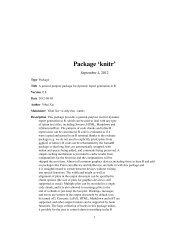Package 'openair'
Package 'openair'
Package 'openair'
Create successful ePaper yourself
Turn your PDF publications into a flip-book with our unique Google optimized e-Paper software.
linearRelation 71auto.textcolsspanEither TRUE (default) or FALSE. If TRUE titles and axis labels will automaticallytry and format pollutant names and units properly e.g. by subscripting the ‘2’ inNO2.Predefined colour scheme, currently only enabled for “greyscale”.span for loess fit. Controls the fit line: lower values produce a more “wiggly”fit.... Other graphical parameters. A useful one to remove the strip with the date rangeon at the top of the plot is to set strip = FALSE.DetailsThe relationships between pollutants can yield some very useful information about source emissionsand how they change. A scatterPlot between two pollutants is the usual way to investigatethe relationship. A linear regression is useful to test the strength of the relationship. However, considerablymore information can be gleaned by considering different time periods, such as how therelationship between two pollutants vary over time, by day of the week, diurnally and so on. ThelinearRelation function does just that - it fits a linear relationship between two pollutants over awide range of time periods determined by period.linearRelation function is particularly useful if background concentrations are first removed fromroadside concentrations, as the increment will relate more directly with changes in emissions. Inthis respect, using linearRelation can provide valuable information on how emissions may havechanged over time, by hour of the day etc. Using the function in this way will require users to dosome basic manipulation with their data first.If a data frame is supplied that contains nox, no2 and o3, the y can be chosen as y = "ox". Infunction will therefore consider total oxidant slope (sum of NO2 + O3), which can provide valuableinformation on likely vehicle primary NO emissions. Note, however, that most roadside sites do nothave ozone measurements and calcFno2 is the alternative.A smooth line is added to all plots except period = "weekday" using smooth.spline. smooth.splineuses Generalized Cross Validation (GCV) to find a line that is neither too wiggly nor too smooth.The line tends to highlight both the overall tendency of a relationship as well as some of the moreinteresting features.ValueAs well as generating the plot itself, linearRelation also returns an object of class “openair”. Theobject includes three main components: call, the command used to generate the plot; data, thedata frame of summarised information used to make the plot; and plot, the plot itself. If retained,e.g. using output
















